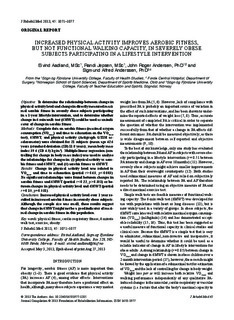| dc.contributor.author | Aadland, Eivind | |
| dc.contributor.author | Jepsen, Randi | |
| dc.contributor.author | Andersen, John Roger | |
| dc.contributor.author | Anderssen, Sigmund Alfred | |
| dc.date.accessioned | 2014-02-04T12:51:48Z | |
| dc.date.available | 2014-02-04T12:51:48Z | |
| dc.date.issued | 2013 | |
| dc.identifier.citation | Journal of Rehabilitation Medicine. 2013, 45, 1071-1077 | |
| dc.identifier.uri | http://hdl.handle.net/11250/149399 | |
| dc.description | From the 1Sogn og Fjordane University College, Faculty of Health Studies, 2 Førde Central Hospital, Department of
Surgery, 3Norwegian School of Sport Sciences, Department of Sports Medicine, Oslo and 4Sogn og Fjordane University
College, Faculty of Teacher Education and Sports, Sogndal, Norway | no_NO |
| dc.description.abstract | Objective: To determine the relationship between change in
physical activity level and change in directly measured maximal
aerobic fitness in severely obese subjects participating
in a 1-year lifestyle intervention, and to determine whether
change in 6-min walk test (6MWT) could be used as an indicator
of change in aerobic fitness.
Methods: Complete data on aerobic fitness (maximal oxygen
consumption (VO2max) and time to exhaustion on the VO2max
test), 6MWT, and physical activity (Actigraph GT1M accelerometer)
were obtained for 21 subjects (mean age 42.6
years (standard deviation (SD) 11.0 years); mean body mass
index 39.6 (SD 4.5) kg/m2). Multiple linear regression (controlling
for change in body mass index) was used to analyse
the relationships for changes in: (i) physical activity vs aerobic
fitness and 6MWT; and (ii) aerobic fitness vs 6MWT.
Results: Change in physical activity level was related to
VO2max and time to exhaustion (partial r > 0.63, p < 0.003).
No significant relationships were found between changes in
aerobic fitness and 6MWT (partial r < 0.22, p > 0.351) or between
changes in physical activity level and 6MWT (partial
r = 0.15, p = 0.531).
Conclusion: Increased physical activity level over 1 year resulted
in increased aerobic fitness in severely obese subjects.
Although the sample size was small, these results suggest
that change in 6MWT might not be a good indicator of maximal
change in aerobic fitness in this population.
Key words: physical fitness; cardio-respiratory fitness; | no_NO |
| dc.language.iso | eng | no_NO |
| dc.publisher | Medical Journals Limited | no_NO |
| dc.subject | physical fitness | no_NO |
| dc.subject | cardio-respiratory fitness | no_NO |
| dc.subject | 6-minute walk test | no_NO |
| dc.subject | exercise | no_NO |
| dc.subject | obesity | no_NO |
| dc.title | Increased physical activity improves aerobic fitness, but not functional walking capacity, in severely obese subjects participating in a lifestyle intervention | no_NO |
| dc.type | Peer reviewed | no_NO |
| dc.type | Journal article | no_NO |
| dc.source.pagenumber | 1071-1077 | no_NO |
| dc.source.volume | 45 | no_NO |
| dc.source.journal | Journal of Rehabilitation Medicine | no_NO |
| dc.source.issue | 10 | no_NO |
| dc.identifier.doi | 10.2340/16501977-1205 | |
